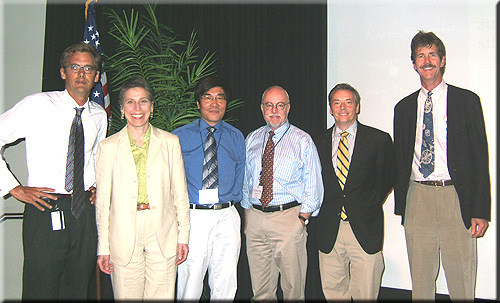Report on the "The Archimedes Palimpsest Symposium" Held in Conjunction with the XIIth International Conference of the History of Science in East Asia (ICHSEA)
Baltimore, MD, USA
18 July, 2008
by Joseph W. Dauben

As part of the XIIth International Conference of the History of Science in East Asia (ICHSEA) held at Johns Hopkins University July 14-18, 2008, the International Commission on the History of Mathematics co-sponsored "The Archimedes Palimpsest Symposium" at the Walters Art Museum in Baltimore on the afternoon of July 18. Before an audience of more than 100, the afternoon began with greetings from Professor Joseph Dauben, organizer of the session, who introduced William Noel, Curator of Manuscripts and Rare Books at the Walters. Dr. Noel, a graduate of Cambridge University, is an expert on Carolingian manuscripts. He spoke in considerable detail about the history of the Archimedes codex, the creation of the palimpsest which contains, among other works of Archimedes, the only known copy of "The Method," the "Stomachion," and "On Floating Bodies." He explained how codices are made and the history of the creation and transfer of the Archimedes palimpsest between various libraries and monasteries from Istanbul to Jerusalem and back. It was in Istanbul that J. L. Heiberg examined the palimpsest in 1906 and managed not only to photograph a portion of the work but also ultimately to produce, with his colleague H. G. Zeuthen, the edited text of "The Method" which was published in 1907. The palimpsest then disappeared again, and sometime probably shortly after the First World War, found its way to Paris, where it remained in the hands of a private collector until its sale by Christie's on October 29, 1998, for $2,200,000. The anonymous purchaser shortly thereafter entrusted the palimpsest to the Walters Art Museum for conservation and study.
Dr. Noel then introduced Abigail Quant, Conservator of Medieval Manuscripts at the Walters since 1984. Trained at Trinity College, Dublin, she has worked in England with Robert Powell, who rebound the Book of Kells. Although she had worked previously on the Dead Sea Scrolls and the Book of Hours of Jean d'Evreux, nothing prepared her, she said, for the challenges she faced in dealing with the Archimedes palimpsest. She described in detail the problems the conservators faced in unbinding the palimpsest and then rescuing it from the centuries of mold that had slowly eaten away at the pages of the codex. Following her presentation, Michael Toth&emdash;Project Manager previously at the National Reconnaissance Office (the "nerve center" as Will Noel described it of the U. S. reconnaissance satellite program) and an expert on imaging systems&emdash;described the technology that has been applied to revealing the contents of the palimpsest, in particular the text and diagrams that are crucial to a correct understanding of Archimedes’ mathematics.
The program continued with two lectures, by Joseph Dauben and Liu Dun, on Archimedes and Archimedean mathematics in China. Professor Dauben, Distinguished Professor of History and History of Science at Lehman College and the Graduate Center of the City University of New York, spoke about "Archimedes and Liu Hui on Circles and Spheres." As he explained, considerable interest in the Archimedes palimpsest has been generated by the careful conservation efforts and powerful scientific tools that revealed previously unobservable details of the original text. This has recently led the historian of ancient mathematics, Reviel Netz (Stanford University), to offer important new insights about Archimedes' Method and the approach he took to determine the volume of the sphere by applying Cavalieri-like indivisibles and using various infinitary arguments. Archimedes is also well-known for his application of the so-called method of exhaustion to approximate the value of pi. Similar interest in the mathematics of circles and spheres also inspired mathematicians in ancient China to consider the problems of determining the ratio of the circumference to the diameter of a circle, and the volume of a sphere. Liu Hui's 3rd-century commentary on the Chinese classic text, Jiuzhang suanshu (Nine Chapters on Mathematical Procedures), addresses these problems in ways that invite comparison with the results and methods of Archimedes. Not only did Liu Hui use inscribed regular polygons to approximate the value of pi, but he approached the problem of the volume of the sphere in terms of the intersection of two cylinders, and later, by applying the same Cavalieri-like indivisibles and infinitary arguments to the problem, the fifth-century mathematician Zu Xuan independently reached the same conclusion as had Archimedes concerning the volume of the sphere. Professor Dauben concluded his presentation by considering similarities as well as differences between the achievements of these two great mathematicians, Archimedes and Liu Hui.
The last to speak in the two-hour symposium was Liu Dun. The former Director of the Institute for History of Natural Science in Beijing, Professor Liu is currently serving his second term as First Vice President of the Division for History of Science of the International Union of History and Philosophy of Science. He is also the Dean of the School of Humanities and Social Sciences of the Chinese University of Science and Technology in He Fei, and serves as the Editor-in-Chief of the quarterly journals, Studies in the History of Natural Science and Science and Culture Review. According to Professor Liu's lecture, "[a]t the end of the Ming Dynasty, in line with the need for calendar reform, Jesuits brought to China a vast array of classical Western astronomical and mathematical knowledge. It was against this backdrop that Archimedes and his deeds were ushered in." In his presentation, Professor Liu explored the process by which, in the course of nearly 400 years, Chinese scholars became acquainted with, apprehended, and probed into Archimedes' life, works, thought, legends, and influences. Professor Liu brought his presentation and the symposium to a close by offering a brief summary of research on Archimedes by Chinese scholars.